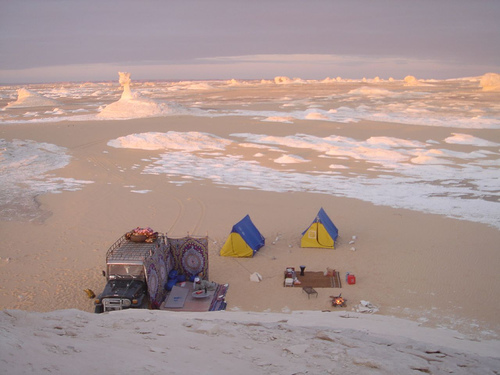
Tour of Western Desert of Egypt is a fascinating journey through remote oasis, namely Siwa, Bahariya, Farafra, Dakhla and Kharga Oasis, the Great Sand Sea or Ramla El Kebir, and Gilf Kebir, a moonscape-like plateau of striking mountain ridges, crater-like formations and rock sculptures. Beyond Bahariya Oasis begins vast Black Desert that turns into surreal environment of the White Desert and makes for a memorable camping site.
The Great Sand Sea, as the name implies, is an endless expanse of sand dunes, in size covering some 70,000 square kilometers, a phenomenal grandeur of Sahara that continues well into Libya. It is a living desert as the dunes move, some of them tens of kilometers long, propelled by the wind, advancing as much as several dozen meters per year.
After the taste of the sea of sand and crossing remote uninhabited desert so much more impressive is sight of a major green oasis with groves of palms, date and olive trees and a clean spring. Such is the sight of Bahariya Oasis, one of the most amazing oases in Egypt.
Bahariya Oasis is not actually a single settlement but rather a collection of several villages, now well connected with the rest of Egypt by good roads. Other than marveling at the oasis architecture and cultivation practices, the discovery of a Greco-Roman necropolis, known as the Valley of the Golden Mummies over a decade ago, a large burial site of several dozen tombs with many more said to be contained within, the Bahariya Oasis has become a prominent archeological excavation site.
The Bahariya Oasis constitutes a great base for exploration of the omnipresent Black Mountains that lie south of the oasis. Among the most memorable is the Valley of Agabat, where the ever encroaching sand dunes meet with impressive yellow rock formations. Not to miss is also the hot spring in the Valley of El Haize. Further on glistens the Crystal Mountain, a rock formation covered with calcite crystals, professed to be once a sub-volcanic vault. The geology of Egypt’s Western Desert mountain formations, in fact of the entire Gilf Kebir plateau is quite remarkable, and the White Desert is its ultimate marvel. The most dazzling part of the White Desert is a snow-white limestone environment of stunning rock shapes created by erosion and weathering, a hydrothermal structures of chalk deposits and limestone carvings, indeed a stunning place to camp for the night.
